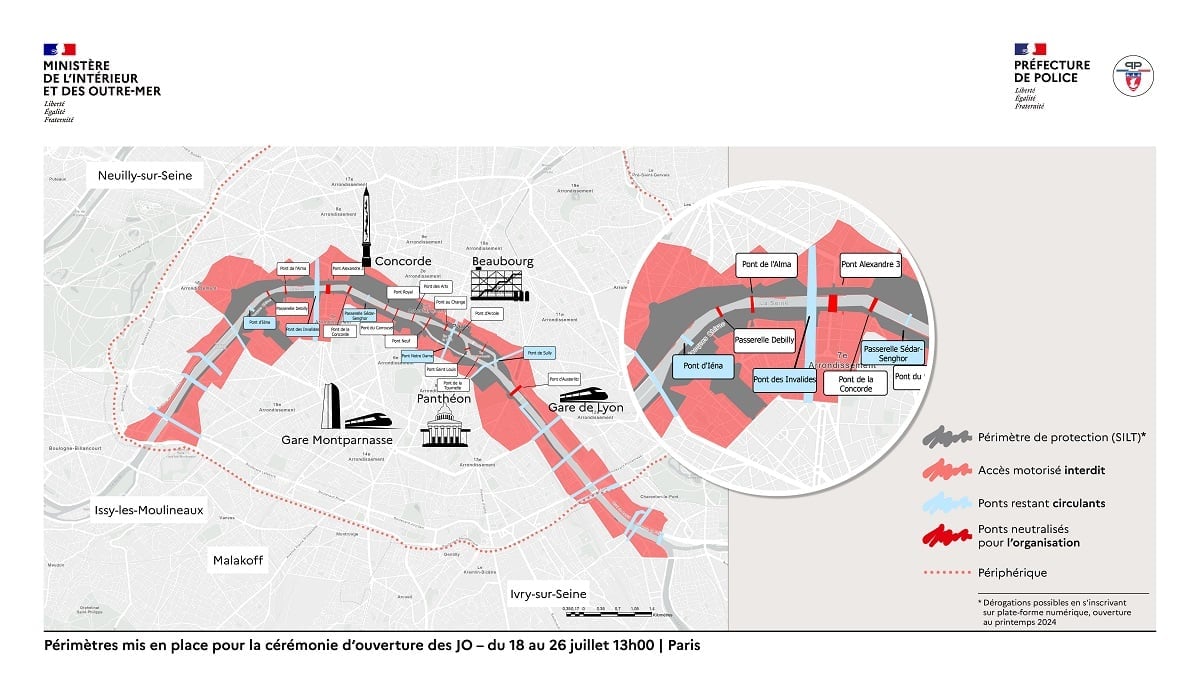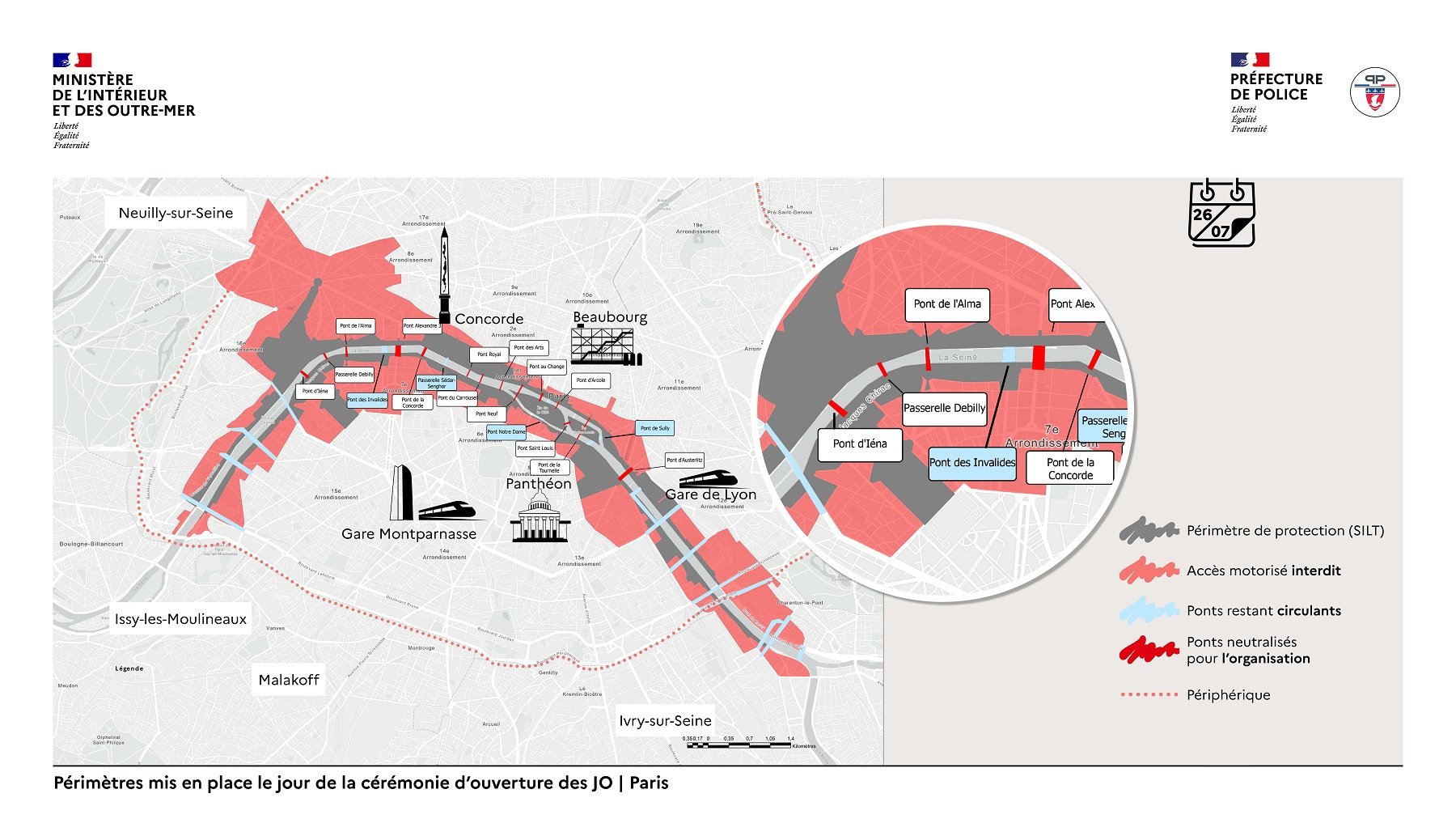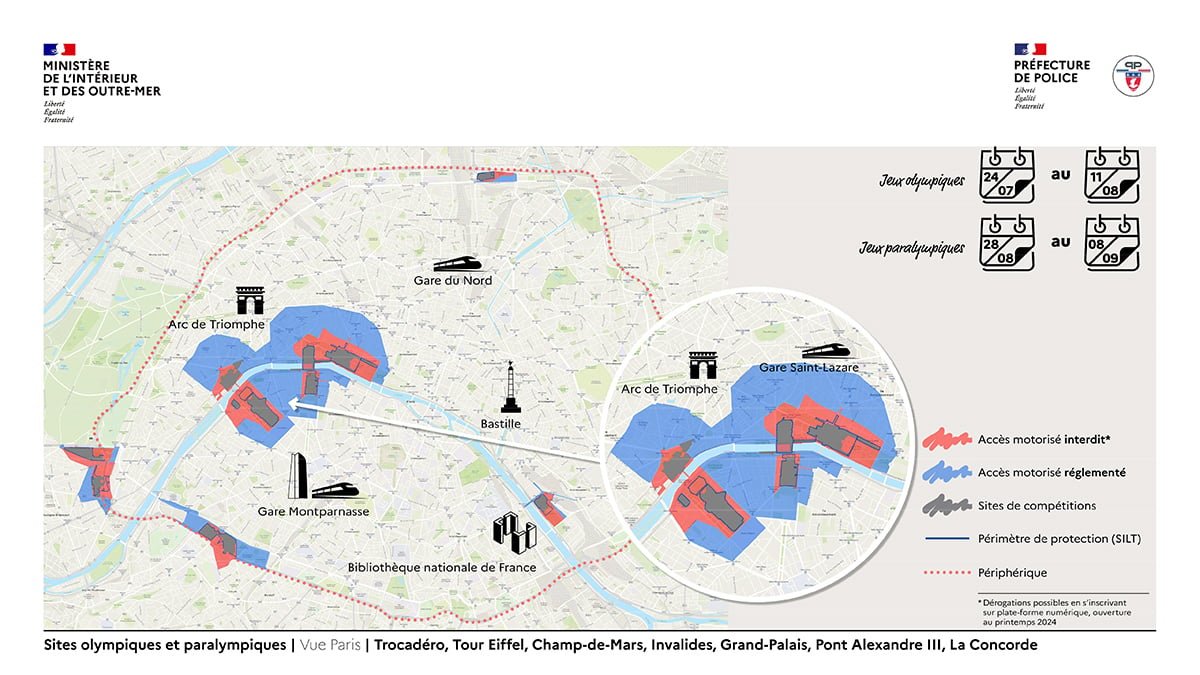The platform to request the QR code – call the Pass Jeux (Games pass) – to get around certain areas of Paris during the Olympics and Paralympics opened to the public on Monday, May 13th.
In July, August and the first week of September, certain areas of Paris will be sectioned off into zones, with some of them requiring a QR code to enter.
The platform to request a QR code is now live.
Who will need a code?
This is the big question for Paris residents and visitors – will you need a code?
And the good news is that most people living in or visiting the city probably won’t – the QR code areas are geographically small and cover only certain dates.
If you have tickets to an Olympic or Paralympic event that is held within a security zone then you won’t need a QR code to enter – you can show your event ticket and ID instead in order to enter the area.
Dates – there are two phases to the security zones plan; phase 1 covers the date of the opening ceremony and the week leading up to it. This is the most restrictive phase and will see large parts of the banks of the Seine in central Paris closed. Once the ceremony is over, most of the riverside areas will open up again and only the areas immediately adjacent to Games venues will be a security zone.
July 18th-July 27th – this is the Opening Ceremony phase with closures of river-side areas in central Paris. The security area will expand slightly from 1pm on July 26th, the day of the ceremony itself. Anyone who has a ticket to the ceremony will not need a QR code to enter the area on the evening of July 26th.
July 27th-September 8th – this is the period of the Games themselves, when security zones will be less widespread.
If you are visiting Paris before July 18th or after September 8th, you do not need to worry about QR codes.
Places – security zones are concentrated in certain areas, mostly in central Paris so if you are in another part of the city you won’t need one.
Below is the map showing security zones for phase one of restrictions – the week leading up to the opening ceremony.
The area shown in dark grey is the bit where QR codes will be required to enter. The red areas are only restricted to motorists but are open to pedestrians and cyclists without the need for a QR code (more on red zones below).

Once the opening ceremony is over we enter phase two, which starts on Saturday, July 27th. As the map below shows, in this phase the security zones are smaller and mostly concentrated around event venues.
The grey areas are those that require either a QR code or a ticket to enter, the red zones are open to pedestrians and cyclists but banned to vehicles while the blue zones are open to pedestrians and cyclists but motorists will require a QR code to enter (find a full explanation on those zones below).

The easiest way to check whether you need a code to visit a specific area is to head to the website Anticiper les Jeux – it’s available in English and you can search by street address and date to see whether you will be in a QR code zone or not.
READ ALSO Paris Olympics QR codes – your questions answered
Exceptions – the QR Code is not required for anyone under the age of 13. It is, however, required for visitors as well as for locals – including people who are staying in hotels that are within the security zone.
If you are arriving by train into a station that is within a security zone you do not need a QR code, you can show your train ticket instead.
The QR code will only be in use in Paris and the greater Paris region, so if you are attending an Olympic event in another city (eg Marseille) you will not need a code.
READ MORE: How to check for Paris Olympics disruption in your area
How do I get a code?
Once you have established that you need a code, the next step is requesting one and this is done online. The process is the same whether you live in Paris or are just visiting and the website is available in French and English.
The platform to request a QR code is now live and you can find it at pass-jeux.gouv.fr/demande/
How does it work?
You will go onto the website and follow the questions asked, including when you would need the QR code for.
There are two sections – one if you need a code for the opening ceremony period (July 18th-26th) and the other for codes during the Games period (July 27th-September 8th). At present only the opening ceremony section is accepting requests, the second part will open soon.
You will be asked a series of questions and for corroborating documentation. These will include whether you need the QR code for yourself or for a vehicle. For those looking to access restricted areas on foot, you will need to state if you are a resident, worker, or visitor (meaning you are making a short trip to someone or some event within the restricted zone).
The ‘resident’ category includes ‘temporary residents’ (ie people staying with friends or in hotels).
You will be required to upload information such as an identity document and proof of address. For those with vehicles, they will also need to add proof of the garage/car park location, and potentially also their vehicle registration document (carte grise).
If you work in the area, you will need to upload proof of where you are employed – either a ‘professional card’ (such as home-help workers) or an attestation from your employer.

After you have completed the questions, authorities will verify your application and you will receive the QR code to enter and exit restricted zones.
You will not receive the code immediately as your details will need to be checked – according to the Paris town hall website this may not be available until just a few days before restrictions take effect, so don’t panic if you don’t get your code straight away.
For people with difficulty accessing the internet, you can ask the mairie of your département for assistance.
What are those zones?
Let’s look in a bit more detail at the zones, because many of these restrictions will only affect you if you want to drive through central Paris – something that we frankly would not advise even in normal times.
SILT (or ‘anti-terrorism’) zones – To enter these areas, you will need either a QR code or a ticket for the event, plus a form of identification.
During the majority of the Olympic Games, the SILT zones will only surround Games venues. However between July 18th and 26th the SILT zone will extend along the Seine and into central Paris.
The below two maps show (top) restricted zones between July 18th and 1pm on July 26th and (bottom) the expanded zone on the day of the opening ceremony itself. These restrictions will be in place from 1pm on July 26th until the ceremony ends – expected to be about 11pm.
People who live and work in these areas will need to register to get a QR code to enter and exit – this covers pedestrians, cyclists and motorists including passengers in a taxi or Uber.
On the maps for the Opening Ceremony, they are marked in grey.


Once the opening ceremony is over, phase two begins with a shrunken SILT area. This comes into effect on Saturday, July 27th and lasts until the Games end on September 8th.
The SILT zones are marked with a dark blue line, denoting the area surrounding event locations. You can see an example below;

Red zones – these are closed to all vehicles and motorbikes, with the exception of local residents, those visiting sick / vulnerable people, emergency and rescue services – these people can register in advance for a special QR code.
It’s important to note that this does NOT affect people walking or cycling through these areas, they can enter as normal and do not need a QR code.
Blue zones – closed to vehicles and motorbikes with the exception of those outlined above for red zones, plus anyone who can provide a justification such as delivery drivers. Pedestrians and cyclists can move freely through the blue zones and do not need a QR code.
Licensed Paris taxis will be able to enter red and blue zones, as will VTC drivers such as Uber who have registered themselves and their vehicle in advance. If you are a passenger in a taxi or Uber you will not require a QR code.
Metro stations in the red and blue zones may be closed or temporarily closed, although Metro lines will continue to run, but without stopping at certain stations.
Grey zones – On most maps, except for the Opening Ceremony, these are the event venues themselves, and will be open only to people who have a ticket to that event, or accredited people such as Games officials or journalists. Security will be tight and bags will be searched on arrival, as is standard at major sporting events in France.
You can find detailed maps here, courtesy of the Paris town hall. You can also watch a short video (in French) explaining the zones from the Paris police prefecture.
Still confused? If you have questions about the security arrangements or any aspects of Games organisation, feel free to leave a comment below or email us on [email protected]



 Please whitelist us to continue reading.
Please whitelist us to continue reading.
Member comments